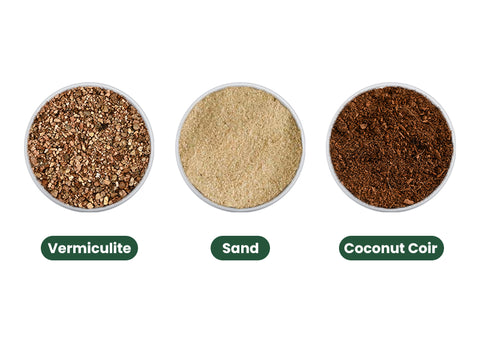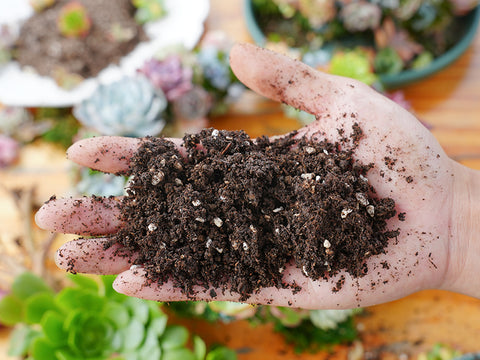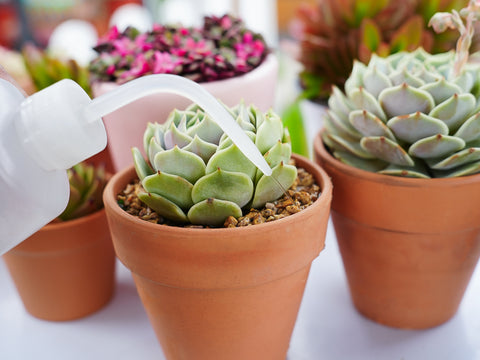Succulents are known for their robust vitality, often sprouting roots even in the open air. In most cases, we need not worry about the rooting process of these hardy plants. However, there are instances when you've had a succulent planted for several months, yet it seems to be dwindling in size. No matter how much you water it, the succulent appears limp and lackluster. This might lead to some concern, prompting you to unearth the succulent from the soil, only to find it hasn't developed any roots at all.
This article compiles the rapid rooting techniques shared by many succulent gardeners, to help your succulent establish roots swiftly, Let's dive in!
3 Ways to Help Succulent Root Growth
Root growth in soil mediums
Compared to standard potted succulent soil, utilizing specific mediums can significantly enhance root development.
Recommended Growing Mediums:
● Sand
● Coconut Coir
These mediums share a common trait—they possess excellent water retention capabilities, providing the essential moisture conditions for robust root growth.
Choose one of these mediums and place it in a propagation tray, ensuring it's thoroughly watered with excess moisture drained. Gently position the succulent cuttings or leaves on top of your chosen medium. Typically, within about a week, you'll witness the emergence of new roots.
Roots that grow in a suitable medium are typically more robust and exhibit greater adaptability to their environment. Consequently, when transplanted into new soil, they tend to thrive and perform even better.
Root growth in air
Intriguingly, succulents can swiftly develop roots even in the open air with the right method. All you need is a bare-root succulent, an empty, clean propagation tray with a dark hue, a spot with diffused light, and a well-ventilated windowsill.
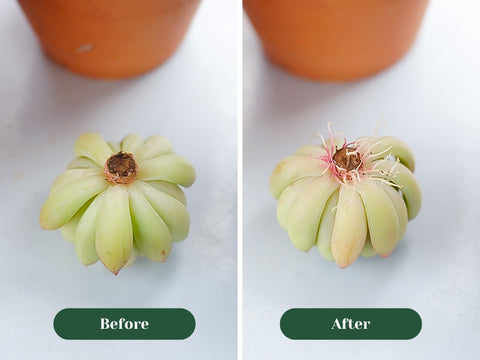
Ensure that the diameter of the propagation tray is slightly smaller than that of the succulent, allowing it to rest comfortably on top. Leverage the Gravitropism and Photophobia exhibited by plant roots to naturally stimulate root hormone production.
One of the key advantages of this method is its simplicity. Aside from a bit of patience, no additional care is required. Typically, after about a week, when you gently pick up the succulent, you'll witness the emergence of brand-new roots.
Grow root in water
When ambient humidity falls short, consider growing succulent roots in water. This technique proves especially effective for varieties like Echeveria, Sedum, Crassula, and those of the Haworthia genus.
You need A transparent bottle, cling film, and string to secure them. Fill the transparent bottle with approximately half of its capacity with water. Cover the mouth of the bottle with cling film, securing it in place with the string. Create small holes in the cling film, allowing the succulent to rest just above the water's surface.
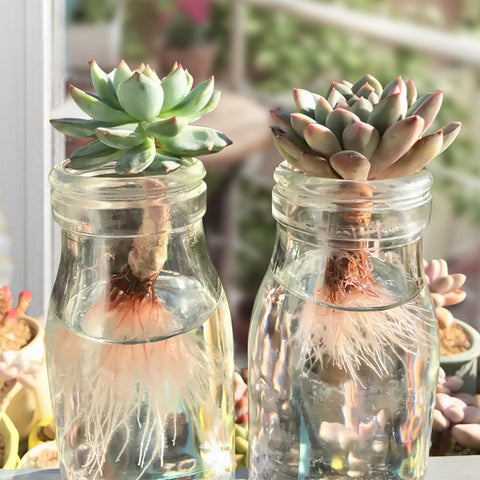
Key Tips for Success
- 1. Allow the succulent's wounds to air dry for 2-3 days before proceeding.
- 2. Apply an additional layer of cling film to maintain a humid environment, expediting root development.
- 3. Ensure the succulent is positioned close to the water's surface without direct contact.
By following these steps and tips, you can observe the succulent's root growth process with enhanced clarity.
In addition to the methods discussed, having a thorough understanding of the factors influencing succulent rooting can greatly assist in promoting rapid root growth.
Factors Influencing Succulent Root Growth
Light: One pivotal factor is the quality of light succulents receive. Gentle, filtered light fosters photosynthesis, driving active growth in the succulent roots.
Temperature: For most succulent plants, a thermic range of 65-80℉ (20-25 ℃) emerges as the sweet spot for root growth. Veering too low, and the pace of root development languishes. Conversely, excessive heat poses the risk of rot.

Humidity: The optimal ambient humidity hovers around 60%, a condition particularly conducive to roots in the air. As for soil moisture, a moderate 30% is the sweet spot.
How long does a succulent grow root?
When succulents find themselves in an optimal growing environment, you can expect them to start rooting in as little as 7 days. Of course, this timeline may vary depending on the specific species and their growth rates. Some speedier varieties may surprise you with tiny roots emerging after just 3 days. This variance can also be attributed to the diverse forms succulents take.
For instance, woody succulents with cork-like textures and younger plants tend to take longer. They're akin to older people, their growth vigor somewhat diminished, necessitating a more patient approach, sometimes up to half a month. However, it's worth noting that various succulent species might enter a dormancy phase at specific temperature thresholds. You might wait a month or more before witnessing any rooting activity during this dormant period.
How to care for succulent after it grows root?
Once succulents have established their roots, we enter the next phase: how to foster and fortify these newfound foundations. The key focus here is watering.
When coaxing succulents to root in air and water, transplant them into the slightly moist soil (The soil looks slightly moist, and touching it won't wet or soil your hands) after observing approximately 1 centimeter of root growth. After the transplant, please give it a thorough watering after three days. At this point, the developing roots will eagerly absorb moisture, initiating a rapid and substantial surge in growth. Simultaneously, they release hormones that inhibit mold growth, affording succulent roots a shield against potential interference.
For succulents rooting in the soil, closely observe their leaves and gently lift them to assess root development. When leaves have depleted a layer or if the succulent lifts effortlessly with the soil, it's time for a thorough watering. A special note for summer watering: in environments with limited ventilation, lightly water around the edges of the succulent pot once a week.


